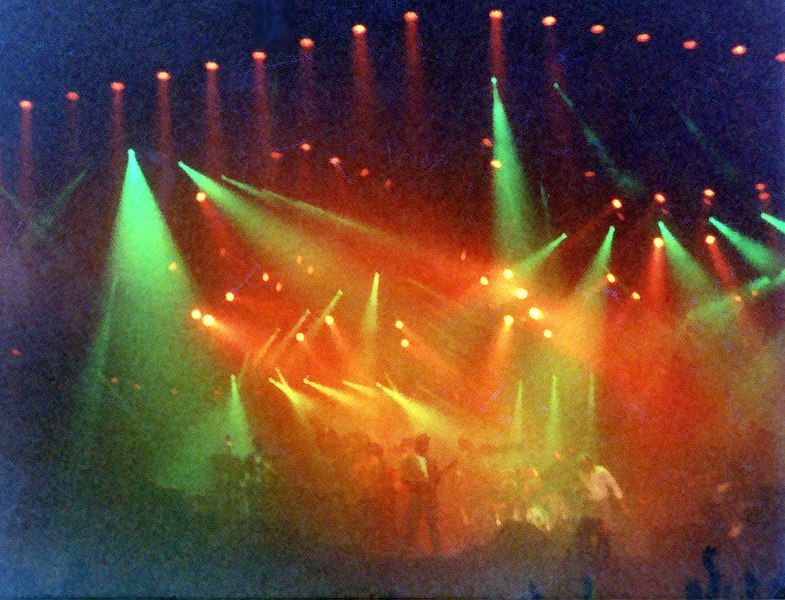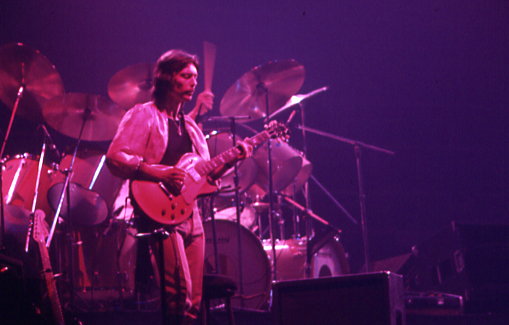On July 4, 1987, Genesis wrapped up their massive Invisible Touch tour with the fourth consecutive sold-out show at Wembley Stadium. It marked the end of a historic run for the band and a high point in their live career.
Invisible Touch: The Album
Released in 1986, Invisible Touch became Genesis’ most commercially successful album, reaching #1 in the UK and #3 in the US. It produced five major hit singles: ‘Invisible Touch’, ‘Tonight Tonight Tonight’, ‘Land of Confusion’, ‘In Too Deep’ and ‘Throwing It All Away’. Tracks like the title song, the moody Tonight, Tonight, Tonight, and Land of Confusion with its iconic Spitting Image video dominated radio, MTV, and the charts throughout 1986 and 1987. Genesis had never been more visible – or more popular.
Naturally, the band embarked on a massive world tour, playing across North America, Australia, Japan, Europe, and finally closing with four sold-out nights at Wembley, playing to nearly 300,000 people.
The Invisible Touch Tour
The tour kicked off in September 1986 in the US and included 112 shows, selling close to two million tickets. The band was joined, as usual, by drummer Chester Thompson and guitarist/bassist Daryl Stuermer.
In Australia and New Zealand, Genesis added a local four-piece string section for In Too Deep and Your Own Special Way, due to union regulations requiring them to employ local musicians.
By this point, Genesis weren’t just a hit-making machine, they were a finely-tuned live band, backed by a state-of-the-art Vari-Lite lighting system and a tight, polished setlist. While they had a vast catalogue to choose from, the shows leaned heavily on songs from Invisible Touch and recent albums.
The Setlist and Show Highlights
Every show opened with Mama, though its eerie atmosphere did not always translate well in daylight stadium settings. The closer was the now-iconic Turn It On Again medley, which featured a whirlwind of rock classics: Everybody Needs Somebody to Love, Satisfaction, Twist and Shout, Pinball Wizard, All Day and All of the Night and Karma Chameleon.
Older fan favorites included: Los Endos, Home By The Sea (with its now-standard ghost-story intro) and the In The Cage medley.
At the beginning of the tour, the In the Cage medley included In That Quiet Earth and the second half of Supper’s Ready. But as the tour progressed, Phil Collins began having trouble hitting some of the higher notes in Supper’s Ready, and the band eventually returned to the familiar In That Quiet Earth / Afterglow ending.
New material from Invisible Touch featured heavily, with standout performances of: Domino (with Phil’s now-legendary audience interaction), Tonight, Tonight, Tonight, Throwing It All Away (where the crowd singalong grew with each night) and Invisible Touch.
Live at Wembley Stadium
‘Nearly 300,000 people at Wembley. OK, there might have been a few repeats in there, but I thought at the time, and I still think now, that moment was the peak of our career’1 – Tony Banks.
By the time Genesis arrived at Wembley, the band had performed the set so often it had become a masterclass in musicianship and stagecraft. Initially, only two nights at Wembley were planned, but due to overwhelming demand, two more were added, making Genesis the first band to play four sold-out shows at Wembley Stadium. They entered the Guinness Book of Records, a record later broken by Michael Jackson during his Bad tour in 1988.
The Wembley concerts were filmed and later released on VHS and DVD (2003). Unfortunately, the epic In the Cage medley did not make it into the final release, (allegedly) due to bad luck with tape changes during that very song on each night.
Even so, the performance captured at Wembley is phenomenal, showcasing Genesis at their live peak. With Invisible Touch, the band had reached global superstardom and Wembley was the victory lap.
After this triumph, fans would have to wait four more years for the next Genesis studio album.
Title photo: Genesis Nancy 1987. Phil Collins, Tony Banks, Mike Rutherford, Daryl Stuermer, Chester Thompson. Genesis en concert à Nancy le 14 juin 1987 au stade Marcel-Picot de Nancy-Tomblaine Source: Wikimedia Commons, Fredamas / CC-BY-SA-2.5 (https://creativecommons.org/licenses/by/3.0).
- in Banks, Tony; Collins, Phil; Gabriel, Peter; Hackett, Steve; Rutherford, Mike; Dodd, Philip, Genesis. Chapter & verse. (New York: Thomas Dunne Books/St. Martin’s Griffin, 2007), p. 287. ↩︎


